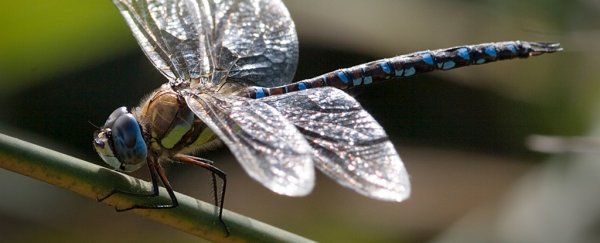When harassed by a suitor that just won't quit, female moorland hawker dragonflies aren't able to say they already have a boyfriend or hand over a fake phone number, so they do the next best thing: they pretend to be a corpse.
Putting aside our urge to anthropomorphise anything with a metabolism for just a moment, the discovery expands our knowledge of a rare form of behaviour only ever seen in a handful of other insects, indicating it could be a more common strategy than we realise.
Entomologist Rassim Khelifa from the University of Zurich, Switzerland, stumbled across the cheeky trick while studying the larvae of the dragonfly species Aeshna juncea in the Swiss Alps several years ago.
As he sat near a pond, waiting for females to lay eggs for his experiment, he watched a pursued dragonfly dive to the ground.
On closer inspection, he realised the fallen insect was female, lying upside down, and motionless on the ground.
"I expected that the female could be unconscious or even dead after her crash landing, but she surprised me by flying away quickly as I approached," Khelifa wrote in his report to the Ecological Society of America.
While we've all pretended to be out when that annoying neighbour comes knocking at the door, a single observation doesn't mean female moorland hawker dragonflies also have trickery on their mind.
So Khelifa set aside time in his research to watch the mating habits of the dragonflies at two ponds.
It's important to note that dragonfly mating isn't a wine-and-dine affair, with the males of many species aggressively intercepting and copulating with females as they zoom in over the water, where they either settle on a leaf or continue to fly about joined in 'tandem linkage'.
Thanks to the fact the female's reproductive tract is at the tip of her long abdomen while the male's penis is up closer to his thorax (or chest section), the pair have to twist themselves into what's called a wheel, where the sex organs lock together until the deed is done.
None of this is all that pleasant, so it's hardly shocking to think that once the female dragonfly has the sperm needed for her eggs, she's hardly going to be keen on risking a second round.
In a number of dragonfly species, the male typically hangs around after copulation, chasing off any other hopefuls keen for a chance at fertilisation.
Not so with the moorland hawker dragonfly.
"After copulation, the male detached himself from the female and flew away," wrote Khelifa.
Usually the females find some protection in the long grass surrounding the ponds, so Khalefia watched as they moved out of the vegetation once they'd deposited their eggs.
"When the female tried to leave the oviposition site, males always chased her on the air," Khelifa wrote.
He observed 35 female dragonflies, of which 31 crashed to the ground when pursued, with 27 of those falling still "feigning death".
Of that total, 21 were successful in avoiding the male.
We won't speculate on the predilections of those other six, but Khalefia reassures us in his paper that the 'drop and freeze' behaviour is less about dissuading the males and more about simply hiding.
He writes, "In addition, that males could not detect the motionless females highlights the importance of movement for males to detect females, which is the case for many odonates."
So we can rest assured there probably won't be any research done on necrophilia among dragonflies in the near future.
Playing dead itself isn't all that unusual in nature, with some species of duck, snake, and the most famous of all, the American opossum, showing a talent for avoiding becoming lunch by resembling a rotting body.
Using the trick to avoid the trauma of unnecessary acts of reproduction is so far only known to exist among a few arthropods, including the robber fly and a species of praying mantid.
"It would be interesting to know whether this scarcity is true or just an artefact related to the lack of behavioural investigations or difficulty in detecting this behaviour," Khelifa wrote.
He also suggests we need a way to classify death feigning in nature that considers a difference between the behaviour of faking death and a more physiological response that reflects a form of unconsciousness.
It's also vital to note that dragonflies are insects, and not people. We don't recommend women drop to the floor to avoid persistent pursuers; we do suggest if there's a lesson for the rest of us, however, is that men need not act like dragonflies.
This research was published in Ecology.
